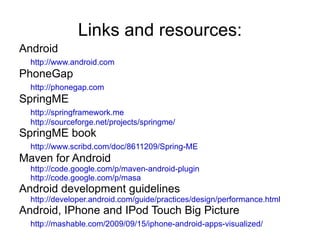Non Conventional Android Programming En
- 1. Non-conventional Android Programming
- 2. Who am I? Davide Cerbo http://jesty.it http://davide.cerbo.born-to-co.de http://www.linkedin.com/in/davidecerbo [email_address]
- 4. Once upon a time...
- 6. Compass
- 7. Camere
- 9. WI-FI
- 10. UMTS / HSPDA
- 11. Multi-touch
- 12. Where we going?
- 13. (market)
- 14. Too much devices
- 15. Many languages for many devices IPhone: Objective C
- 16. Android: Java
- 17. BlackBerry: Java
- 18. Nokia/Symbian: Java e C++
- 19. Windows Mobile: .NET e C
- 20. Write once, run anywhere Do you remember?
- 21. PhoneGap HTML + JAVASCRIPT + CSS = PhoneGap.com
- 22. PhoneGap CROSS PLATFORM + API NATIVE INTERFACES + OPEN SOURCE = PhoneGap.com
- 23. What I'm able to do? ...and coming soon: camera, maps and file manager
- 24. Examples //GEO REFERENCING var getLocation = function () { var suc = function ( p ){ alert ( p . coords . latitude + " " + p . coords . longitude ); }; var fail = function (){ alert ( "Location not available!" );}; navigator . geolocation . getCurrentPosition ( suc , fail , undefined ); } //VIBRACALL navigator . notification . vibrate ( 0 ); //BEEEEEEP navigator . notification . beep ( 2 );
- 25. Examples //ACCELEROMETER var watchAccel = function () { var s = function ( a ){ document . getElementById ( 'x' ). innerHTML = roundNumber ( a . x ); document . getElementById ( 'y' ). innerHTML = roundNumber ( a . y ); document . getElementById ( 'z' ). innerHTML = roundNumber ( a . z ); }; var d = function (){}; var opt = {}; opt . frequency = 100 ; Timer = navigator . accelerometer . watchAcceleration ( s , f , opt ); } //CAMERA navigator . camera . getPicture ( dump_pic , fail , { quality : 50 }); function dump_pic ( data) { ... document . getElementById ( "test" ). src = "data:image/jpeg;base64," + data ; }
- 26. Where's the trick? PhoneGap give us a startup project for every supported device. Every project is a simple application made of a web browser that work as a fullscreen app and where javascripts object will be injected. These objects has native API counterpart inside the device. We need to copy html, css, javascript and images into a specific project folder for every device that we need to deploy on. We also need to modify the project configuration, like project's name, author and so on... For Android copy these files into: ../my-android/assets/www/
- 27. Just to explain... ...take a look at this piece of code extracted from DroidGap.java included in the Android startup project: private void bindBrowser(WebView appView) { gap = new PhoneGap( this , appView); geo = new GeoBroker(appView, this ); accel = new AccelListener( this , appView); launcher = new CameraLauncher(appView, this ); // This creates the new javascript interfaces for PhoneGap appView.addJavascriptInterface( gap , "DroidGap" ); appView.addJavascriptInterface( geo , "Geo" ); appView.addJavascriptInterface( accel , "Accel" ); appView.addJavascriptInterface( launcher , "GapCam" ); }
- 28. Why Android? Open Source
- 29. Linux and Java based (Dalvik)
- 30. So many Devices
- 31. OS highly customized ?
- 32. Android 2.0 (Eclair) in deep Multiple Google accounts management
- 33. Microsoft Excange Server support
- 34. Home, Menu and Back buttons become optional
- 35. New HTML5 web browser
- 36. Camera application improved (flash, digital zoom, etc...)
- 37. SMS and MMS are now searchable
- 40. SpringME Object configuration through XML
- 41. No reflection needed, auto-code generation
- 42. The final package does not contain extra libraries
- 43. Developed and maintained by Wilfred Springer, ex Tom Tom Software Architect
- 44. Apache MAVEN artifact plugin
- 45. Designed for J2ME but also suitable for GWT and Android
- 46. SpringME: how does it works? Spring use reflection for Dependency Injection Class cl = Class.forName("Person"); Object instance = cl.newInstance(); Method meth = cl.getDeclaredMethod("setName"); method.invoke(instance, new Object[] { "Nick Hornby" }); --------------------------------------------------------- ClassPathXmlApplicationContext appContext = new ClassPathXmlApplicationContext(...); BeanFactory factory = (BeanFactory) appContext; Person frank = (Person)factory.getBean(“frank”);
- 47. SpringME produce the code through the Apache Maven plugin Person instance = new Person(); instance.setName("Wilfred Springer"); --------------------------------------------------------- BeanFactory factory = new BeanFactory(); Person frank1 = (Person)factory.getBean(“frank”); Person frank2 = factory.getFrank();
- 48. Android + Maven Install the Android SDK
- 49. Setup the env variable ANDROID_SDK_15
- 50. Install Android into our maven repository , for example: mvn install:install-file -DgroupId=android -DartifactId=android -Dversion=1.5_r2 -Dpackaging=jar -Dfile=$ANDROID_SDK_15/platforms/android-1.5/android.jar
- 51. Let's create a brand new project: android create project --target 3 --name MavenAndroidExample --path ./maven-android-example --activity MavenAndroidActivity --package it.jesty.mavenandroid.example
- 52. Android + Maven Create a pom.xml file (we'll see it in the next slide)
- 53. Let's clean up the mess: rm -r bin build.xml build.properties libs
- 54. Create the emulator: android create avd --name mavenandroidadv --target 3
- 55. Execute the emulator: emulator -avd mavenandroidadv
- 56. Create our package with: mvn install (.apk file)
- 57. Let's deploy the .apk into our device: mvn com.jayway.maven.plugins.android.generation2:maven-android-plugin:deploy
- 58. ... <dependencies> <dependency> <groupId> android </groupId> <artifactId> android </artifactId> <version> 1.5_r2 </version> <scope> provided </scope> </dependency> </dependencies> <build> <sourceDirectory> src </sourceDirectory> <plugins> <plugin> <groupId> com.jayway.maven.plugins.android.generation2 </groupId> <artifactId> maven-android-plugin </artifactId> <version> 2.1.0 </version> <configuration> <sdk> <path> ${env.ANDROID_SDK_15} </path> <platform> 1.5 </platform> </sdk> <deleteConflictingFiles> True </deleteConflictingFiles> </configuration> <extensions> true </extensions> </plugin> ... Android + Maven
- 60. Android + Maven + SpringME Modify the pom.xml adding the SpringME plugin
- 61. Create the application-context.xml into /context: <beans> <bean id="ciao" class="it.jesty....Greeting" scope="prototype"> <constructor-arg value="Ciao" /> </bean> </beans>
- 62. Create the Greeting.java class
- 63. Modify the MavenAndroidActivity.java: public void onCreate(Bundle savedInstanceState) { super .onCreate(savedInstanceState); TextView tv = new TextView( this ); tv.setText(((Greeting)new BeanFactory().getBean( "ciao" )) .to( "MavenAndroidActivity" )); //oppure: tv.setText(((Greeting)new BeanFactory().getCiao()).to(...)); }
- 64. Repeat 8 and 9 steps mvn com.jayway.maven.plugins.android.generation2:maven-android-plugin:deploy
- 65. ... <resources> <resource> <directory>${basedir}/context/</directory> <filtering>true</filtering> <includes> <include>**/*.xml</include> </includes> </resource> <resource> <directory> ${basedir}/target/generated-sources/spring-me </directory> </resource> </resources> <plugins> <plugin> <groupId>me.springframework</groupId> <artifactId>spring-me-maven-plugin</artifactId> <version>1.0-SNAPSHOT</version> <executions> <execution> <goals> <goal>generate</goal> <goal>dot</goal> </goals> <phase>generate-sources</phase> </execution> </executions> <configuration> <contextFile> ${basedir}/context/application-context.xml </contextFile> <className> it.jesty.mavenandroid.example.BeanFactory </className> <dotFile>${basedir}/target/poloko-context.dot</dotFile> </configuration> </plugin> ...
- 66. Android + Maven + SpringME <?xml version="1.0" encoding="UTF-8"?> <beans xmlns="http://www.springframework.org/schema/beans" xmlns:xsi="http://www.w3.org/2001/XMLSchema-instance" xsi:schemaLocation=" http://www.springframework.org/schema /beans http://www.springframework.org/schema/beans/spring- beans-2.0.xsd" default-lazy-init="true" > <bean id="ciao" class="it.jesty...Greeting" scope="prototype" > <constructor-arg value="Ciao" /> </bean> <bean id="hello" class="it.jest...Greeting" scope="prototype" > <constructor-arg value="Hello" /> </bean> </beans>
- 67. Android + Maven + SpringME package it.jesty.mavenandroid.example; public class Greeting { private String greeting; public Greeting(String greeting){ this .greeting = greeting; } public String to(String to){ return this .greeting + ", " + to; } }
- 69. Links and resources: Android http://www.android.com
- 73. Maven for Android http://code.google.com/p/maven-android-plugin http://code.google.com/p/masa
- 74. Android development guidelines http://developer.android.com/guide/practices/design/performance.html
- 75. Android, IPhone and IPod Touch Big Picture http://mashable.com/2009/09/15/iphone-android-apps-visualized/
- 76. Examples download: http://jesty.it/non-conventional-android-programming.zip The archive file contains: PhoneGap for Android demo
- 77. Apache Maven for Android examples
- 78. SpringME examples ...all fully functional !!! :)

![Who am I? Davide Cerbo http://jesty.it http://davide.cerbo.born-to-co.de http://www.linkedin.com/in/davidecerbo [email_address]](https://image.slidesharecdn.com/non-conventional-android-programmingen-091104041044-phpapp01/85/Non-Conventional-Android-Programming-En-2-320.jpg)
![http://www.pro-netics.it [email_address]](https://image.slidesharecdn.com/non-conventional-android-programmingen-091104041044-phpapp01/85/Non-Conventional-Android-Programming-En-3-320.jpg)
































